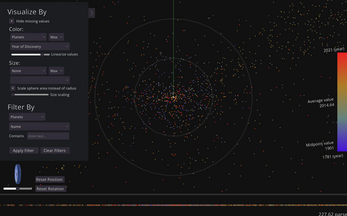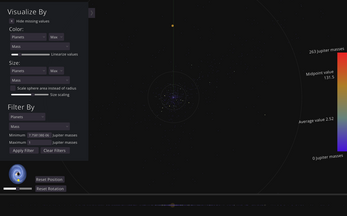Exoplanet Map
This project is made for a Visualization course. It uses the Open Exoplanet Catalogue dataset. I didn't preprocess the data as it is already processed well. When visualizing a property, planetary systems missing that property can be hidden. The application visualizes planetary systems as spheres. Each planetary system contains at least one planet. There can be stars and binary stars with planets orbiting them, and these can be nested.
The main window displays an intersection through our galaxy in orthographic projection. There are no planetary systems hidden behind the camera. The default view is centered on our solar system, perpendicular to the galactic plane. The center of the galaxy is upward, as indicated by a green line.
In the bottom left corner, there is a galaxy model indicating the current camera angle.
The bottom panel displays a view parallel to the galactic plane, with planetary systems projected into an (almost flat) line. This serves to indicate the 'density' of systems in the main view and to make finding lone stars and outliers easier.
Detailed information for each planetary system can be viewed.
The visualization allows for camera movement and rotation. Planetary systems can be visualized with color and size depending on any numerical property they have. Star temperatures are colored depending on their color in the visible spectrum, other properties are colored using a blue-red gradient. When using color, the current gradient is shown on the right side of the screen.
Planetary systems can be filtered by properties of a star or planet. Numerical properties are filtered in minimum to maximum range, text properties are filtered by text they contain (search).
Screenshots on the right side show:
- Color by year the planet was discovered
- Color and size by star mass
- Color and size by planet mass, only with less mass than Jupiter
- Color by star temperature, showing detail of one system
Controls:
- A small plus shows current pivot position
- Move on a plane using WASD or direction keys
- Zoom using Mouse Scroll Wheen (minimal size of system is 1 pixel)
- Rotate around pivot by holding Right Mouse Button
- Rotate on other axis using slider on the bottom left
- Reset position and rotation using buttons on the bottom left
- Open details by Left Clicking a system, close by clicking empty space
- System color, size and filtering is in the left panel
- Max/Min boxes - which value to vis in systems with multiple planets/stars
- Linearize values - Distributes skewed properties more evenly in gradient
Features I didn't have time to add:
- Selecting box regions using mouse
- Filtering based on distance and constellation
- Text labels for our solar system and galaxy center
- Show range for size similar to the gradient
- Scaling size and color relative to current filtering
- Less ugly code
Download
Install instructions
The web version uses a fixed dataset due to web security reasons. The standalone version automatically uses the current dataset, or you can put your version of the dataset into /StreamingAssets




Leave a comment
Log in with itch.io to leave a comment.